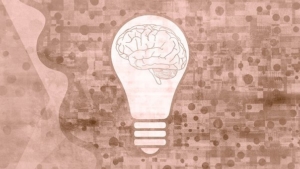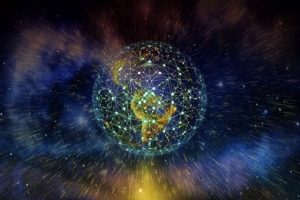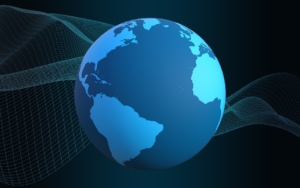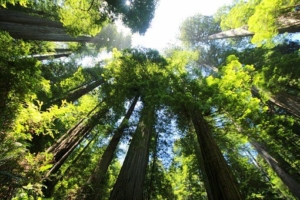Essay #6: Gaia Vision

One of the most brilliant, insightful integral thinkers I ever had the chance to converse with was William Irwin Thompson. He was gracious enough to be a guest on my radio program for two hours back in 2002.
Bill Thompson was a philosopher, cultural historian and founder of the Lindisfarne Association, a network of scientists, artists and religious scholars who got together to discuss what Bill called “Planetary Culture.” Listening to Bill or reading his work, one gets the sense he has not only read virtually every important book in the humanities and general sciences, but integrated them into a unique, wholistic vision.
What I remember most about radio our conversation was not the content of what he said, but his style which he himself described as “poetic, philosophical mind-jazz” (clearly a right-hemisphere style of thinking).
For this essay I focus one of his essays, “It’s Already Begun, The Planetary Age is an unacknowledged daily reality.”
Written in 1985, it’s relevant for global shifts going on right now and serves as a good view of Bill’s integral mind.
“We live in a culture that we do not see. We don’t live in industrial civilization; we live in planetization. For example, we all think we live in a world that’s structured according to industrial nation-states that engage in activities of trade and warfare that are weighed and measured by certain quantitative forms. That’s the conscious structure of the world that we call reality. The unconscious structure of the world is that there are all kinds of forms of dark exchange called pollution – atmospheric things like acid rain and the greenhouse effect and changes in the oceans – and that these are the integrations that are bringing us all together. We are in an implosive situation of planetary integration, but where is the planetary culture expressed?”
The key reference here is to “the unconscious.” Most academic disciplines are limited to what can be seen and felt consciously. But it’s been an accepted scientific fact that some 95 percent of our behavior is generated by the unconscious. When Bill refers to the “quantitative forms” which can be “weighed and measured” as the “conscious structure of the world we call reality,” he is alluding to what we now know as the limitation of the left-hemisphere of our brains which is not comfortable with and often blind to the less predictable, less measurable, but significantly more influential qualities of the unconscious which need to be brought into light.

Emerging Signals
Bill then goes on to make the right-hemisphere insight that phenomena such as greenhouse gases and acid rain can be seen from the depth psychological level as signals rising out of the collective unconscious and forming a more visible planetary vison. Bill’s insights in this essay came when the internet was a not a highly usable tool by the general public, before the world wide web was even created.
He expands on the essence of the emerging “planetary culture:”
“And it’s expressed with those people who are sensitive to the unconscious, who live at the membrane between the culture’s conscious system, called civilization and writing and literacy, and those who face the intuitive dimensions of the unconscious. These are the artists. These are the prophets…. There is also planetary culture in the forms of electronic communication, of the whole grid of satellites that enables us to exist in forms that have nothing to do with the reality of the industrial nation-state.”
Again, we see right-hemisphere qualities being elevated with reference to “intuitive dimensions of the unconscious.” As discussed in previous essays here, unconscious impulses are much better absorbed and understood by the adaptive, empathic, non-verbal, expanded vision qualities of the right hemisphere (what psychotherapist Allan Schore calls “the essential right-brain process of non-conscious affect regulation”), the ability to integrate emotion and meaning into a larger vision.
It’s also useful to note that Bill met with and was influenced by the communications theorist Marshall McLuhan, whose insights into technology as extensions of the human mind and body are featured in Essays #3&4.
Bill writes,
“We are now at the stage where there is an unconscious form of shadowed integration, where we are living in a planetary culture, but we are trying to describe it and weigh it and measure it in all the systems of consciousness of industrial values, industrial structures and industrial nation-states. This creates an incredible cognitive dissonance.”
Aha! Again, we bump into the phrase, “cognitive dissonance.” When this website first went online, we posted the quote of Buddhist teacher Robert Thurman, our first webinar guest:
“Wisdom is the tolerance of cognitive dissonance.”
This psychological phenomenon of cognitive dissonance was again referenced in the previous two essays, relating to Arthur C. Clark’s explanation for HAL’s brain imploding in 2001: A Space Odyssey and relating to the therapeutic and spiritual power of the enduring Yin/Yang symbol. Cognitive dissonance refers to the psychological pressure felt when holding two or more contradictory thoughts, values or beliefs at the same time. This pressure will most likely cause us to end the conflict by choosing one thought or value or belief. But as Robert Thurman suggests, tolerating the “dissonance”, holding the apparently contradictory thoughts in the mind can lead to a greater truth.
Bill Thompson brings up cognitive dissonance in reference to the situation that in 1985 (still true today) most people were viewing the world through the lens of the industrial age whereas a number of intuitive right-hemisphere thinkers were tuning into an emergent global mind-set percolating up from the collective unconscious, a shift into a new ‘planetary culture.’
“So right now, everything in our content of consciousness is industrial nation-state, traditional forms, the modern world that we have had since 1500. And we keep bumping into things. We bump into the atmosphere. We bump into people. We bump into Indians. We bump into Russians. We bump into Shiites or Palestinians. And we keep wondering, what the hell’s going on? The maps don’t work. Where are we?”
Bill was anticipating the situation we are in now as TV screens, Websites and newspapers send out pictures and commentary on culture-bending issues from Women’s Right and Blacks Live Matter to Immigration Reform and, the shape-shifter of them all, Climate Change. While these are specific political and social issues on the one hand (left-hemisphere focus), they are also, as integral thinkers like Bill Thompson point out, deep-seated, invisible rumblings from the collective unconscious signaling a seismic shift to a more integrated, digitally networked, planetary culture (right hemisphere).

From Civilization to Planetization
“You can’t fix civilization. Civilization is militarization. So, the first thing you have to have is a transformation of consciousness. You have to move from civilization to planetization and realize the world we are really living in, where we are all mutually involved in one another.”
This “transformation of consciousness” clearly happened in the late 1960’s when horrific images of innocent Vietnamese men, women and children being napalmed were transmitted onto millions of TV screens in living rooms across the country were credited as a pivotal point in changing the public’s view of that war.
And in 2010, a Tunisian street vendor, Mohamed Bouazizi, trying to sell enough fruit to feed his family, was ordered by police to hand over his cart because he lacked a permit. Humiliated and despondent, he protested by setting himself on fire in front of a government building. His act was captured by cellphones, posted on the Internet and quickly set off what is now referred to as the “Arab Spring,” a series of powerful, expanding protests which forced the resignation of political despots and uprisings across the Middle East.
“Once you begin to see what’s really going on in the world, you won’t see the future. Forget about prophecies. We’re just talking about what’s happening now. When you look at the stars, you know you’re seeing the past. But maybe in the soul, when an event happened ‘out there,’ you would know it in your heart even though the light would take time to come to you. So, there are times when you look out at history and read the newspapers, but you don’t really see what’s going on. Then you imagine these fantasies of prophecies about the future far, far away, but all of those prophecies of the future are the actual daily news. Your heart is telling you what’s going on.”
Here is Bill integrating astrophysics, relativity, the human psyche, history, spiritual values and media theory all in one paragraph. There’s a key point here he makes about the false distinctions we’ve been taught regarding past, present and future. It’s not the straight line, clearly marked linear graphs in the history textbooks we were tested on in school. By tuning into what’s actually going on right now (requiring both the conscious, empirical, quantitative level of left-hemisphere focus AND the intuitive, imaginative, unconscious knowing of the right-hemisphere) we actually see the future by paying deep attention to the present.

Gaia Politique
Bill’s essay ends with:
“I think the politics of the 90’s will be the emergence of a Gaia politique. That’s not America; that’s the planet. That’s all of us.”
First, while “industrialization” was still the ruling vision of the 1990’s (it seemed every week there was yet another corporate CEO being celebrated on the cover of Time Magazine for their ability to increase profits), the 1990’s, influenced under the surface and above by the emerging World Wide Web, can now be seen as a significant global rallying cry for environmental sanity. A few examples:
1990: the UN issues its first report on Climate Change;
1991: Sweden becomes the first nation to develop a carbon tax;
1997: Julia Butterfly Hill, protesting the logging of historic redwood trees in California, climbs up one of the trees and lives above ground on it for two years.
This last event speaks to how the influence of one person, despite no visible political or financial power platform, but by living on a small wooden platform high on Redwood tree branches, can, with good timing and deep soul-commitment, change the perception of millions of people.
Some highlights of Julia Butterfly Hill‘s protest which affected global consciousness:
- To insure the 1500-year-old tree would not be cut down by the Pacific Lumber Company as planned, Julia lived on two 6 by 6-foot platforms above ground;
- She almost never washed her feet so that the sap from the tree could help her feet stick better to the branches;
- She used a small propane stove for heat and cooking; a support crew of eight brought in survival supplies which Julia pulled up on ropes;
- She put with freezing rains, El Nino high winds, and a ten-day siege by Pacific Lumber Company security guards as well as helicopter harassment;
- She used solar powered cell phones for radio interviews and was named “in-tree” correspondent for a cable TV show;
- Her protest was resolved when the lumber company agreed to preserve the tree along with other redwoods within a 200-foot radius.

When Julia Butterfly Hill climbed onto that tree, 97 percent of the redwood forest, which once stretched 400 miles, had been cut down for lumber (literally the left-hemisphere not seeing the forest for the trees…or not caring about the forest and just seeing the material profit from the trees).
But one physically frail woman stopped the total destruction and added a powerful spark to the global environmental movement. She was quoted afterwards:
“When I entered the great majestic cathedral of the redwood forest for the first time, my spirit knew it had found what it was searching for. I dropped to my knees and began to cry, because I was so overwhelmed by the wisdom, energy, and spirituality housed in this holiest of temples.”
Julia’s spiritual act absorbs Bill Thompson’s insight, “You can’t fix civilization. Civilization is militarization. So, the first thing you have to have is a transformation of consciousness. You have to move from civilization to planetization and realize the world we are really living in, where we are all mutually involved in one another.”
Shifting Consciousness
In his essay, “The End of the Age of Religion and the Birth of Symbiotic Consciousness” Bill writes,
“The linearity of left-brain thinking was now to be balanced with a right-brain activation.”
More specifically, he imagines the potential integration of neuroscience, depth psychology and philosophy:
“The brain may be a three-dimensional volume, but neurons in separate parts of the brain can fire together in the neuronal synchrony of the range of 40 Hertz. The geometry of the synchronies engages as facets of the higher-dimensional geometries of the subtle bodies—where both the Dalai Lama and Rudolf Steiner say memory is stored—so the play of consciousness should not simply be reduced to a section of the brain3. Cultures have in the past called this process of consciousness, imagination or intuition, but whatever one calls it, it is basic to the creative process in art, science and spiritual contemplative practice.”
In the Mission Statement of this website we cite one of the crucial shifts for the 21st century being “from individual intelligence to collaborative intelligence.” This “collaborative” synergy is with other human minds AND also with nature’s inherent patterns of flow and integration.
This shift requires more imagination, which means we are less interested in the practical results, more tuned into the emerging, self-organizing oscillations of change expressing the deeper meanings of the planetary shift rumbling under our feet and setting off new synaptic leaps within our brains.
CODA:
Whether or not Bill is right about the details he offers about the shift from civilization to planetization is secondary to the effect of his right-brain oriented, imaginative integration of cultural history, science, art, philosophy, and spiritual awareness.
“Militarization” and territorial aggression are the dark side of the left hemisphere’s need for certainty and its inability to see past its own substantial, but limited wiring.
This was revealed in a seminal book published in 1966: “The Territorial Imperative: A Personal Inquiry into the Animal Origins of Property and Nations” by Robert Ardrey details the mammalian brain’s instinct to defend its boundaries against any perceived threat, real or not. In us humans in led to a left hemisphere tight focus on property ownership and empire expansion legitimized as necessary protection against invaders
Of course, it hasn’t been determined yet whether we humans will in great enough numbers shift our consciousness from the “territorial imperative” to a more right-hemisphere “planetization” instinct Bill Thompson called for and sensed was percolating under the surface of the 24-hour news cycle.
The Key Point:
What makes great right-hemisphere thinkers is not being highly accurate or proven right,
but able to stimulate the imagination
and creatively expand the blueprint of the next paradigm shift.
In 1978, the New York Times aptly described the big picture integral mind of William Irwin Thompson in a review titled “Prophet In the Mode:”
“W1LLIAM IRWIN THOMPSON wants people to think big. Instead of worrying about tomorrow, he would prefer them to worry about all of human history. He would like them to give up their “small” preoccupation with paychecks, marriages or personal mortality in order to speculate about the influence of sunspots on civilization, or to consider a curious analogy he suggests between the life‐cycle of cultures and the initiatory stages of the lumined yogi.”
William Irwin Thompson, one of the most brilliant, spiritually-driven intellects of the modern age, died last December on the winter solstice. Leave it to Bill to have his spirit depart on such a transformational, liminal time of the year.
END.
The following poem, which connects nature’s majestic redwood trees to some of the great visionary and artistic minds which have passed on is written by Victoria Sullivan, the poet laureate of the radio talk show, The WoodstockRoundtable, which I host on Radio Woodstock, 100.1FM.
THE MIGHTY DEAD
Charles Bukowski
William Burroughs
Allen Ginsberg
Albert Camus
Leo Tolstoy
Zelda Fitzgerald
Samuel Beckett
These are my mighty dead
These and so many more:
the trees fall in the forest, and I hear them,
redwoods, ancient redwoods,
echoes of greatness
carried in the wind, like
William Butler Yeats
Baudelaire
James Joyce
William Blake
James Baldwin
Langston Hughes—
& others, so many others…
the giants of history
Like Churchill and Lincoln
& Mandela
and Native Americans
Crazy Horse & Sitting Bull, Geronimo,
Stumbling along the trail of tears
The mighty dead, the mighty dead
They sing a song of blood & loss,
The mighty dead.
Their cries & sighs reverberate
like a migraine
like a knife to the chest
The mighty dead march on
in the very air around us,
if we hear their music
2
if we whistle their song
pluck their strings
blow their horn.
I want the voice of Edith Piaf
of Annie Lenox, Janis Joplin
Willie Nelson
Tom Waits
I want a voice that shivers on the spine.
Give me a voice to sing of the mighty dead.
They visit me at night in smoky dreams,
the air thick, they don’t want our tears.
They want our faith. They say that mighty souls
unborn are yet to come. The mighty dead
have not died in vain. Their laughter
and their pain carry us on to other battlefields,
not for wars this time—so crude a method, no,
now we march into the brightest light:
places we have never been or seen.
The mighty dead wait for us to truly live,
and that will be their mighty legacy.
Victoria Sullivan November 2020
